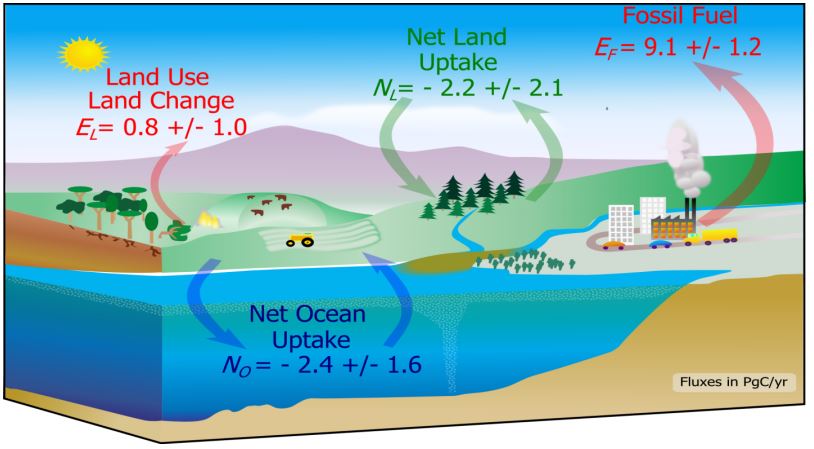A new study confirms that planet Earth is able to absorb more CO2 in parallel with the rising emissions. Approximately half of all the CO2 (carbon dioxide) that is emitted into the atmosphere is taken up by marine and land ecosystems.
The findings of this latest study, co-authored by Richard A. Houghton Ph.D., a Senior Scientist at the Woods Hole Research Center, and published in the academic journal Biogeosciences (citation below), confirm that over the past 55 years at least, half the CO2 emissions have been taken up by Earth’s ecosystems.
Dr. Houghton said:
“There is no question that land and oceans have, for at least the last five and half decades, been taking up about half of the carbon emitted each year. The outstanding question is, Why? Most of the processes responsible for that uptake would be expected to slow down as the Earth warms, but we haven’t seen it yet.”

Diagram of the global carbon budget in the year 2010. (Image: biogeosciences.net)
“Since the emissions today are three times higher than they were in the 1960s, this increased uptake by land and ocean is not only surprising; it’s good news.”
“Without it, the concentration of CO2 in the atmosphere would be twice what it is, and climate change would be much farther along. But, there’s no guarantee that it will continue.”
Monitoring of atmospheric CO2 concentrations started in 1956 at the Mauna Loa Observatory in Hawaii. Since then, several more stations have been added to gauge how much carbon there is in the atmosphere, and how levels vary according to seasons and geographical location.
With these measurements, scientists can detect changes in the behaviour of the global carbon cycle. The carbon cycle is how carbon in all its different forms moves between animals, plants, the ocean and the atmosphere.
In this new study, the researchers outlined a new framework for assessing errors and their impact on the uncertainties associated when calculating carbon sinks on land and in the sea.
Carbon uptake has kept up with emissions
Dr. Houghton and team concluded that the greater certainty in atmospheric carbon measurements has resulted in an increased certainty in the calculated rate of carbon uptake by land and oceans.
They are completely sure that the rates so far have increased in proportion to emission, i.e. the carbon uptake is keeping up with emissions, they say.
Monitoring that carbon uptake annually is vital for understanding the carbon cycle and for knowing how to deal with it, they said.
The Woods Hole Research Center is an independent research institute that investigates pressing environmental issues, including climate change, through scientific and policy initiatives. It was established in 1985 in Woods Hole, Massachusetts, by ecologist George Woodwell.
In a separate study, scientists from the Lawrence Berkeley National Laboratory announced in February that they had observed, for the first time, an increase in the greenhouse effect from carbon dioxide at the Earth’s surface.
Most countries across the world have agreed to set carbon emission caps. Companies that exceed their limits can adhere to regulations by purchasing leftover allowances from low CO2 emitters.
Citation: “Audit of the global carbon budget: estimate errors and their impact on uptake uncertainty,” A. P. Ballantyne, R. Andres, R. Houghton, B. D. Stocker, R. Wanninkhof, W. Anderegg, L. A. Cooper, M. DeGrandpre, P. P. Tans, J. B. Miller, C. Alden8, and J. W. C. White. Biogeosciences. Published 30 April 2015. DOI: 10.5194/bg-12-2565-2015.

